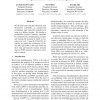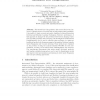133 search results - page 5 / 27 » Learning to Merge Word Senses |
ACL
2004
13 years 9 months ago
2004
Supervised learning methods for WSD yield better performance than unsupervised methods. Yet the availability of clean training data for the former is still a severe challenge. In ...
ECAI
2000
Springer
13 years 12 months ago
2000
Springer
Abstract. This paper describes an experimental comparison between two standard supervised learning methods, namely Naive Bayes and Exemplar–basedclassification, on the Word Sens...
EMNLP
2007
13 years 9 months ago
2007
We develop latent Dirichlet allocation with WORDNET (LDAWN), an unsupervised probabilistic topic model that includes word sense as a hidden variable. We develop a probabilistic po...
NLDB
2005
Springer
14 years 1 months ago
2005
Springer
Abstract. Automated Text Categorization has reached the levels of accuracy of human experts. Provided that enough training data is available, it is possible to learn accurate autom...
COLING
2000
13 years 9 months ago
2000
In this paper, word sense dismnbiguation (WSD) accuracy achievable by a probabilistic classifier, using very milfimal training sets, is investigated. \Ve made the assuml)tiou that...


